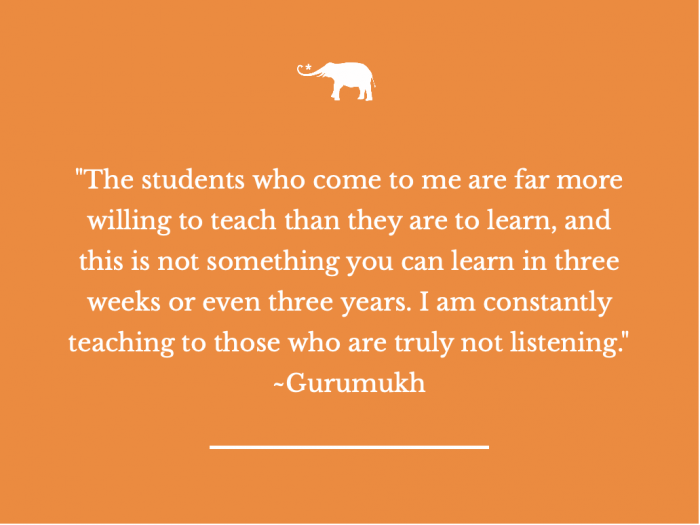While on a yoga retreat in Bali, I was eating breakfast with a man from India who I consider one of the best yoga and meditation masters walking the earth today.
A man who quite literally thanks the earth every time his foot hits the ground, in whose presence I have witnessed the blossoming of countless souls.
I spent months with him and each day was a spontaneous adventure into the nature of life, unraveling its hidden miracles. Simultaneously the most grounded and mystical person I have ever known, he has been a pillar of radiant happiness in my life from the moment I met him in 2014, in Northern India.
But on this day, he was sad.
Bewildered as to what could make a man like this sad, I asked him what the matter was. After a long silence, he began to speak.
“The real teachings of yoga are misunderstood. You can’t learn them by accumulating information like we are taught in school. Yoga is a way of living and there are no shortcuts. Until the teachings have completely transformed your life, you can’t understand them. People come from all over the world to my training to memorize the poses to get their certification. Whose validation do you need if yoga is with you every time you take a breath? To understand the path, one must become the path.”
He paused for a while before continuing.
“The messages can only meet someone when they put aside the ambition to teach them. The students who come to me are far more willing to teach than they are to learn, and this is not something you can learn in three weeks or even three years.”
“I am constantly teaching to those who are truly not listening. Today it is making my heart sad.”
The man speaking is Amrit Pal Singh (Gurumukh). Gurumukh spent his childhood from age 7-19 in a traditional yoga ashram in India, where he mostly ate the same meals every day and meditated for three-hour stretches daily. When he was 19, his master deemed him ready to leave to begin sharing what he had learned.
Navigating this new world of yoga where students can get a teaching certificate for money in two weeks, at times has been a source of conflict for Gurumukh.
“Traditionally in India, 12 years of study was considered the minimum time required to be prepared to start sharing. The master was always there to determine if the student was truly ready. If students began sharing the teachings before this time, they would often miss the subtleties of the teachings and share information that would ultimately only confuse the students,” Gurumukh said.
The yoga industry is booming. Yoga teachers are not only growing, but they are also growing exponentially. There are two people interested in becoming a yoga teacher for every one current teacher, according to the “Yoga in America” study by Yoga Journal. There were 36.7 million U.S. yoga practitioners, up from 20.4 million in 2012.
Initially, it’s easy to look at these astounding growth figures with a sour eye. However, it’s hard to frame the explosive growth of yoga on planet Earth as anything but net-positive. Is it really all that bad if there are millions of yoga teachers everywhere?
Gurumukh believes the growth of yoga is wonderful and that there is no problem with what is happening.
“The best way for a new yoga student to approach this practice is with the expectation that they will be studying for at least five years intensely before they consider teaching,” said Gurumukh.
“The challenge the industry will have to confront is how to continue to offer more in-depth training for those seeking a more traditional experience,” he said.
This is far cry from the typical 28-day, 200-hour teacher training course which is standard on the market. As the industry evolves, the role of the 200-hour teacher training program shifts. 100 years ago, you could get a job on Wall Street with a high school diploma. As the industry evolved, competition arose, and more education became necessary. It seems likely this will be the case in the yoga industry as well.
The reality is there’s nothing wrong with doing teacher training, but students need to learn to contextualize this initial training as part of a larger life effort to prepare themselves to teach yoga, which may take years or decades of practice.
200 hours is just an introduction.
According to Gurumukh, only about 20 percent of the students who come to his teacher training aspire to be teachers, mostly they are seeking an immersive experience with yoga.
What does the future of yoga look like?
Will the industry continue to offer lower price points, shorter training, and unmet promises? Or will the industry recognize the need for more in-depth training and experiences?
The truth is, nobody really knows the answer to this, and there will likely be movements happening simultaneously.
Schools are now offering 6-month courses that teach a style of yoga different from modern Vinyasa. The practices are much closer to what you would have learned in a traditional yoga ashram in India, where the real intention of the practice is to gently prepare the body for long hours of silent meditation.
“Hopefully, more schools will continue offering in-depth training that guides students deeper into meditation,” said Gurumukh.
~












Read 10 comments and reply